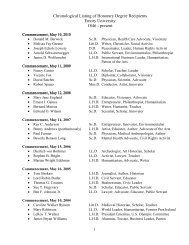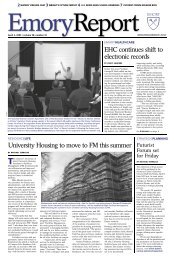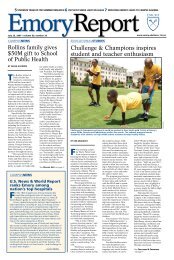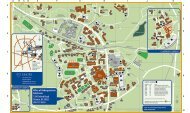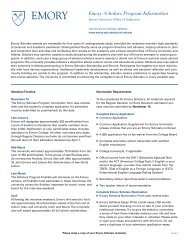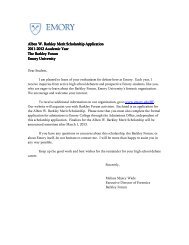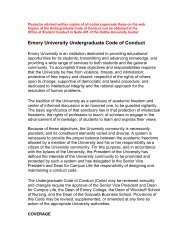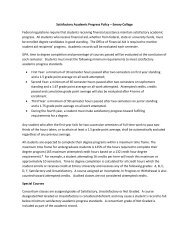DOSY Experiments - Emory University
DOSY Experiments - Emory University
DOSY Experiments - Emory University
Create successful ePaper yourself
Turn your PDF publications into a flip-book with our unique Google optimized e-Paper software.
gzlvlhs gradient level for sspul<br />
hsgt gradient duration for sspul<br />
probe_ stores the probe name used to acquire the dosy experiment<br />
Processing Parameters:<br />
determines the number of components to be used in fitting the<br />
ncomp<br />
signal decay in <strong>DOSY</strong> when dosyproc='discrete'.<br />
nugflag<br />
nugcal_[1-5]<br />
dosyproc<br />
dosybypoints<br />
'n' uses simple mono- or multi-exponential fitting to estimate<br />
diffusion coefficients<br />
'y' uses a modified Stejskal-Tanner equation in which the exponent<br />
is replaced by a power series.<br />
a 5-membered parameter array summarizing the results of the<br />
calibration of non-uniform field gradients. Used if nugflag='y',<br />
requires a preliminary NUG-calibration by the Doneshot_nugmap<br />
sequence. The values are taken from the probe file at the time of<br />
the data acquisition<br />
'discrete' - invokes monoexponential fitting with dosyfit if ncomp=1,<br />
and multiexponential fitting with the external programme SPLMOD<br />
if ncomp>1.<br />
'continuous' invokes processing with the external programme<br />
CONTIN and gives a continuous distribution in the diffusion<br />
domain.<br />
'n' divides the spectrum into individual peaks, creating one crosspeak<br />
for each individual peak found in the 1D spectrum<br />
'y' performs a diffusion fit for every point in the displayed region of<br />
the spectrum that lies above the selected threshold.<br />
4.4.2 Comparison of diffusion results obtained with and without<br />
convection compensation<br />
This chapter compares experimental results of an aqueous solution of a mixture of nicotinic acid<br />
amide and amikacin (see Figure 12 for the structural formulas). The diffusion experiments were<br />
performed without (sequence: Dbppste) and with convection compensation (sequence:<br />
Dbppste_cc) at two different temperatures: 30 °C and 60 °C, respectively, in a 5 mm sample<br />
tube. One may think that this sample in not particularly challenging because the components<br />
differ significantly in size (or molecular weight) and there is no signal overlap between the<br />
aromatic and the sugar protons in the 500 MHz spectrum of the mixture. Both components,<br />
however, contain numerous proton lines (remember the <strong>DOSY</strong> analysis handles multiplet<br />
components individually) and therefore the sample is particularly suitable to provide information<br />
about the accuracy of the diffusion data.<br />
42






